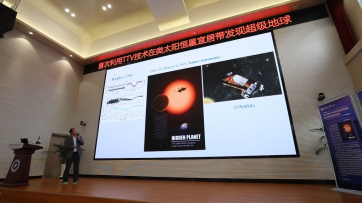
The ancient question of whether life exists beyond Earth continues to fascinate us. A significant discovery now brings us closer to an answer. An international team, led by Chinese scientists from the Yunnan Observatories, has used a clever method called transit timing variation (TTV) to find a promising planet. They detected a “super-Earth”, named Kepler-725c, orbiting within the habitable zone of a sun-like star, Kepler-725.
The planet’s host star resembles our Sun but is younger, only 1.6 billion years old, with stronger surface magnetic (磁的) activity. Kepler-725c itself is large, about ten times Earth’s mass. It completes an orbit every 207.5 days, placing it within the habitable zone — where temperatures might allow liquid water– a key need for life. This system lies about 2,472 light years away from the solar system.
How did scientists find a planet they couldn’t directly observe? Researcher Wang Xiaobin explained the TTV method: it’s like noticing a clock running fast or slow, indicating someone secretly moved its hands. Instead of needing to see the planet transit its star or measuring the star’s wobble (摆动), TTV works differently. By carefully measuring tiny timing changes in the transits of another known planet in the system, the gas giant Kepler-725b (orbiting every 39.64 days), scientists inferred Kepler-725c’s presence, mass, and orbit.
The TTV technique is especially powerful for finding smaller, potentially Earth-like planets with longer orbits in habitable zones. It overcomes limitations of the transit and radial velocity methods. As researcher Sun Leilei noted, this discovery proves TTV’s potential to find low-mass planets around sun-like stars. It provides valuable targets and technical support for upcoming Chinese projects like the China Space Station Telescope (CSST) and the Earth 2.0 (ET) project.
The research team, a collaboration between the Yunnan Observatories, Xi’an Jiaotong-Liverpool University, the Nanjing Institute of Astronomical Optics and Technology, and Hamburg Observatory, emphasizes that more study is needed. They will combine TTV with other methods like transmission spectroscopy to see if Kepler-725c truly has Earth-like conditions.
原创编写 版权所有 侵权必究! 每日更新 个性化阅读 英语飙升!






 更多优质学习内容
更多优质学习内容



